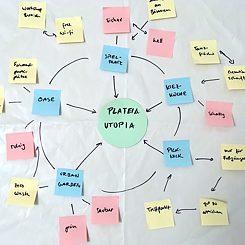Utopia in My City
Module 5
School // Workshop // Age 15–18 // 3 hours // 3–4 lessons
Mindmap // moodboard // Society // community // active citizenship // design // utopian spirit // the New Human // Bauhaus in my city
YOU WILL NEED:
 Silke Wittig | CC BY-NC-SA 4.0
Silke Wittig | CC BY-NC-SA 4.0
- Sticky notes or round moderation cards in different sizes and colours
- flipchart paper
- marker pens
- A3 paper
- pens
- glue sticks
- paper and fabric remnants with different colours and textures
- magazines to cut up
- grasses and leaves
INSTRUCTIONS
In this module participants learn about the social motivation of the Bauhaus and its utopian spirit. What did the idea of the “new human’ involve? What did it mean in practice, this utopia of “designing” society as a whole by giving aesthetic shape to everyday routines? After a historical contextualisation, examples of houses and housing projects are critically examined. Which objectives, ideas and utopias were they able to put into practice? Which utopias remained utopian and failed the hurdle of implementation? Following the introduction to the topic, participants are encouraged to apply the ideas about optimisation of housing and urban space to everyday life today, and to their own city. What would I like to change in my city, in my surroundings? What can I change myself by shaping my surroundings? What effects do colour, form and material have? What moods do they generate?Step 1: To begin, participants are given an introduction on the founding of the Bauhaus, the historical context, the aftermath of the First World War, and Walter Gropius’s ideas about art training.
Step 2: Next the concept of the “new human’ is critically examined. The objectives and principles of experimental training at the Bauhaus are explored and concrete examples investigated (chairs by Marcel Breuer, housing by Walter Gropius). Do the objects and buildings fulfil the utopian ideas about the new human?
Step 3: Participants form small groups to take a closer look at their everyday surroundings and identify specific places or spaces they would like to change, places where they could put their ideas about the ideal life into practice. This could be a public square, the schoolyard, a place in the neighbourhood, a shared courtyard in a residential building, a sports facility, a playground – or even a classroom or a specific room at home.
Step 4: Now a mindmap is produced for the selected case. Each group takes a large sheet of flipchart paper and a couple of round coloured cards or sticky notes to create a mindmap. First of all the place must be given a name. The name is written on a coloured card and stuck in the middle.
Step 5: Now smaller cards or sticky notes are used to note important aspects and describe the ideal condition. Individual terms and keywords may be used, or longer descriptions. To begin with, all the participants’ ideas and dreams should be noted freely and without limits or contradiction (brainstorming). Social, community and ecological aspects should also be noted, alongside absolutely personal interests. At this stage it is irrelevant whether the ideas remain utopian or have a chance of becoming reality. The cards are attached in a circle around the name of the place and joined to it with lines.
Step 6: Now the group discusses its mindmap. What feelings do participants connect with their utopian place? What colours and images do they associate with it? How would they like to change it?
Step 7: Now each participant creates their own moodboard to express their ideas. This takes the form of a collage using various materials and colours, as well as drawings, keywords, and pictures and details cut out from magazines. Before choosing materials to combine with the colours they should touch and feel them and investigate their effects.
Step 8: The completed mindmaps and moodboards are displayed in the classroom or workshop space and the participants present their ideas to the group as a whole. What do the colours, materials, images and descriptions convey?
Optional: Step 9: In a further step the question of implementation could be investigated. Which aspects could actually be put into practice? What would that involve in practice? What problems might arise? How could they be solved? What rules would be needed for the place to function in everyday life? What would the next concrete step be, who could I take my ideas to?
